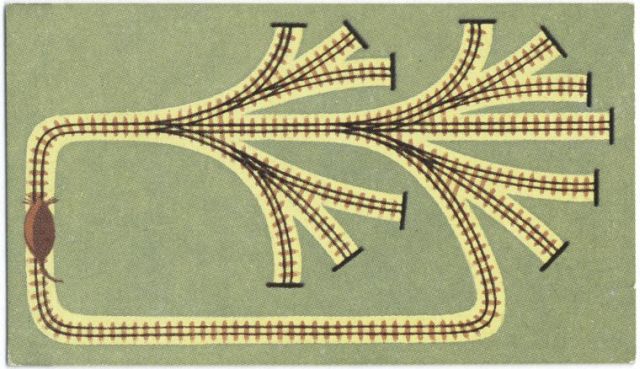MECHANICAL RAT FINDS WAY IN MAZE – Popular Science Nov 1935
As if endowed with powers of reasoning, a mechanical “rat” devised by Dr. Stevenson Smith, University of Washington psychologist, threads its way through an artificial maze like those used to study the behavior of living rats. The three-wheeled, electric-powered device moves along a grooved path that divides at several points, obliging the “rat” to choose which direction to follow. If it takes the wrong turn and enters a blind alley, mechanical feelers cause it to halt, retrace its journey, and try again until the whole course is negotiated successfully. The odd model is designed to show how automatic reflexes differ from thinking processes.
Ogden Standard Examiner 01 September 1935
HUMANS TAKE BACK SEAT TO MACHINE RATSPsychology Professor Says Memory of New Devices Exceeds Mankind
SEATTLE, -Aug. 31.—(AP)—"Mechanical rat," described by Dr. Stevenson Smith, University of Washington psychology professor, as "able to remember what it has learned far better than any man.or animal can remember," was demonstrated here today.
"No living organism could be depended upon to make- no mistakes after one practice," Dr. Smith said.
"That is what this 'rat' can do".
Dr Smith then demonstrated the device, a small foot-long mechanism powered by a small electric motor, on three wheels, which groped its way through a maze of wooden tracks, across a long recitation room.
The first time it "failed," but by bumping a protruding piece of metal into a bumper at the end of the wrong track, it "learned that it shouldn't try that switch again. Under its own power after hitting the bumper, it retreated back beyond the switch, and "found" the other track and then proceeded forward.
The second time it was started at the beginning of the 40-foot maze, it moved across the room, making no mistakes.
Dr. Smith gave most of the credit for its development to Thomas Ross of McClips, Wash., a junior student at the university.
Psychologists over the country have been working on the problem trying to develop such a device, Dr. Smith said.
"What is its practical value?" he was asked.
"We hardly know or foresee just now what can be done with it," he replied.
"I think, however, in studying the problem of learning, it will be useful to teach students some things and I also think it may teach psychologists some, too."
Time, Monday, Sep. 16, 1935
Robot Rat
In Seattle last week Dr. Stevenson Smith, University of Washington psychology professor, delighted colleagues and students by showing them a complicated "mechanical rat" which he and a helper had worked five years to perfect. Living rats, especially white ones, are favorites with animal psychologists who teach them to traverse complex mazes bristling with blind alleys, studying the effect on maze-learning of food, light, electric shock, drugs, blasts of air.
The Stevenson rat is impervious to all such lures and hindrances. Resembling a three-wheeled roller skate loaded with small motors, electromagnets and switches, the robot is set on a track containing twelve forks at each of which a wrong turn leads to a dead-end. The robot is first set to take the turn to the right at every fork. When this proves to be wrong and results in a bump against the dead-end, the "rat" goes into reverse, backs up past the fork, goes forward again, taking the correct left turn. This resets the controls in such a way as to enable the "rat" on the second try to negotiate the maze from start to finish without a single error.
"This machine," said its inventor, "remembers what it has learned far better than any man or animal. No living organism can be depended upon to make no errors of this type after one trial."


Image Title: Teaching a machine to think.
Additional Name(s): Max — Publisher
Medium: Offset-Litho.
Specific Material Type: photomechanical prints
Item/Page/Plate: 62
Standard Reference: Cartophilic reference books, W70-4-
Source: [Cigarette cards.] Age of Power and Wonder.
Source Description: 250 cigarette cards, 3.4 x 6.7 cm and 5.7 x 7.6 cm.
Location: Stephen A. Schwarzman Building / George Arents Collection
Catalog Call Number: Arents Cigarette Cards
Digital ID: 407639
Record ID: 222704
See also Thomas Ross' earlier Maze solver.